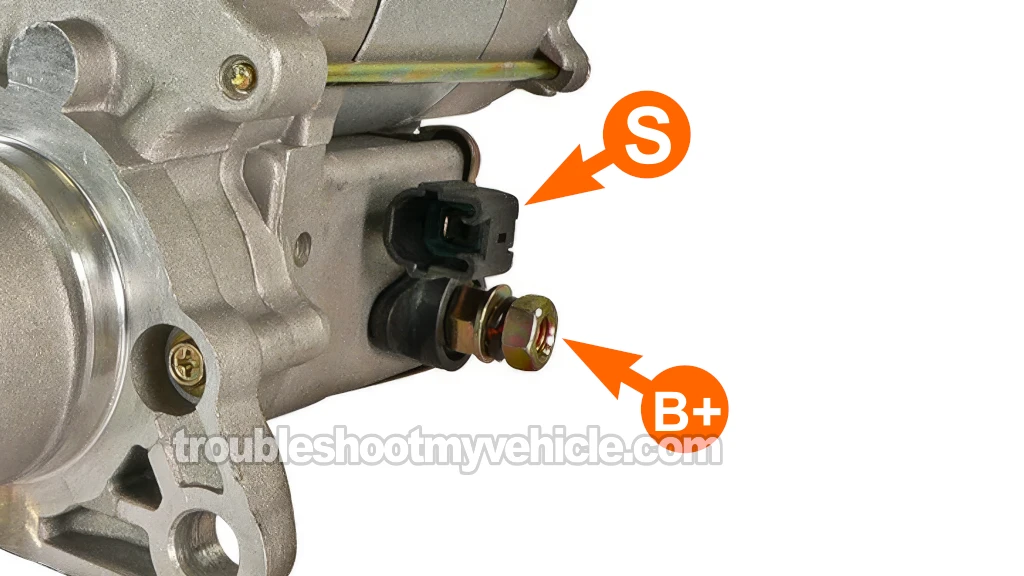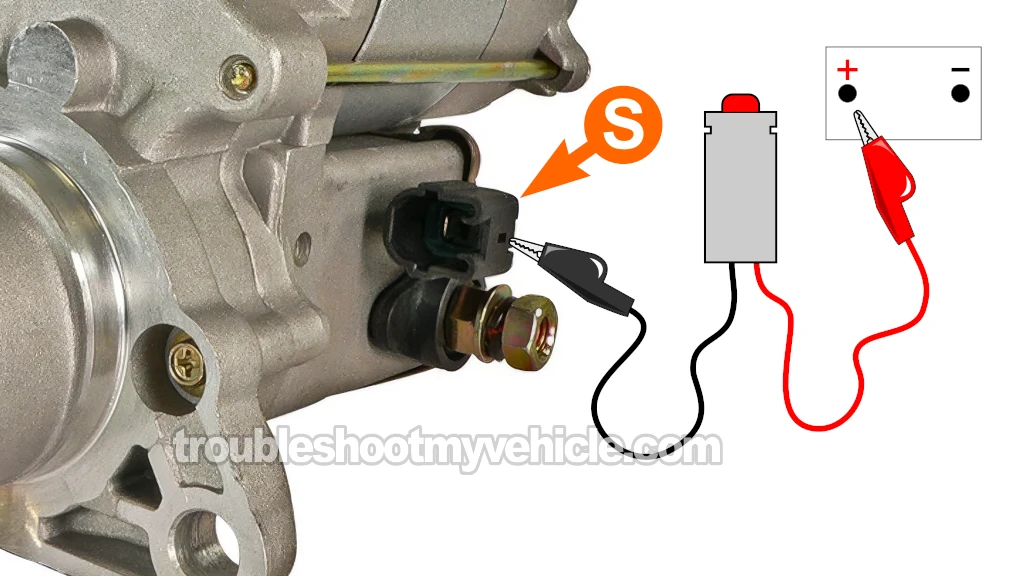
Testing the starter motor on the 1992-2001 2.2L Toyota Camry is pretty easy. I'm gonna walk you through the testing process step by step in this tutorial.
Once you've got your test results, you'll know right away if the starter motor's good or shot (and the cause of the engine's no-crank problem).
NOTE: This test is done on the car, so you won't need to pull the starter motor out. The pics I'm using show it off the car just to make the test connections clearer.
Contents of this tutorial:
- Important Testing Tips.
- Symptoms Of A Bad Starter Motor.
- Tools Needed To Test The Starter Motor.
- The Two Types Toyota Camry Starter Motors.
- TEST 1: Applying 12 Volts To The 'S' Terminal.
- TEST 2: Verifying The 12 Volt Start Signal.
- TEST 3: Voltage Drop Testing The Battery (+) Cable.
- More 2.2L Toyota Camry Tutorials.
APPLIES TO: This tutorial applies to the following vehicles:
- 2.2L Toyota Camry: 1992, 1993, 1994, 1995, 1996, 1997, 1998, 1999, 2000, 2001.
Engine No-Crank Diagnostic Essentials:
Important Testing Tips
TIP 1: This is an on-car test of the starter motor, so no need to remove the starter motor to test it (unless you're gonna bench-test it).
The illustration show the starter motor off of the vehicle just to make it easier to explain the test connections.
TIP 2: Make sure the battery's fully charged before you start any of these tests.
NOTE: A bad battery will cause the starter motor to not crank the engine. If the battery doesn't hold a charge after fully charging it, you've found the cause of your Camry's no-crank problem.
TIP 3: Clean off any corrosion from the battery posts and cable terminals before you get started.
TIP 4: If you've already pulled the starter motor out, you can bench test it instead. This tutorial explains how:
- How To Bench Test A Starter Motor (Step by Step) (at: easyautodiagnostics.com)
TIP 5: The starter motor can be accessed from the engine compartment, so no need to raise the vehicle. But if you do —use jack stands for safety. Don't rely on just the jack to hold the car up while you're under it!
TIP 6: Stay safe out there. Wear safety glasses when you're under the car, and think safety at all times.
Symptoms Of A Bad Starter Motor
If your Toyota Camry's starter motor's going bad or is bad, you'll gonna notice one of these issues:
- The engine won't crank at all. Basically, you turn the key to start it, but nothing happens.
- The engine cranks most of the time but acts up now and then. These intermittent problems require testing the starter motor when it's not cranking the engine.
The most important thing to remember, if the starter motor's acting up intermittently, is that you've gotta test it when it's not working. Testing it while it's cranking the engine won't tell you much —it'll just show it's working fine at that moment.
Tools Needed To Test The Starter Motor
The great thing about testing the starter motor is you don't need any fancy diagnostic tools. Here's a simple list of what you'll need to test the starter motor on your 2.2L Toyota Camry:
- Remote starter switch:
- This tool will help you apply voltage directly to the starter motor safely and easily.
- Want to see what a remote starter switch looks like? Check out this link: Actron CP7853 Remote Starter Switch For 6V And 12V Automotive Starting Systems.
- You can either buy this tool online or you can buy it at your local auto parts store (AutoZone, O'Reilly Auto Parts, etc.).
- A multimeter or a 12 Volt automotive test light:
- We're gonna use the multimeter to check for voltage and Ground.
- If you don't have a multimeter or need to upgrade yours, check out my recommendation here: Buying A Digital Multimeter For Automotive Diagnostic Testing (at: easyautodiagnostics.com).
- A wire piercing probe:
- This tool is not an 'absolute must-have tool' but I can tell you from experience that it makes it a whole lot easier to probe the 'S' terminal wire for the Start Signal.
- If you'd like to see what this tool looks like, you find out more about it here: Wire Piercing Probe Tool Review (Power Probe PWPPPPP01).
- A helper:
- Having someone turn the key (from the inside of the vehicle) or to help set up the test can make troubleshooting the starter a whole lot easier!
Toyota Camry Starter Motor Basics

The starter motor's got two key circuits you need to know about:
- 'S' circuit:
- This circuit sends the START signal to the starter motor when you turn the key to crank the engine.
- The 'S' terminal's a male spade terminal on the starter motor, and the wire connecting to it has a female terminal.
- 'B+' circuit:
- This circuit delivers battery power (voltage/amperage) from the battery to the starter motor.
- The 'B+' terminal's a threaded stud on the starter motor. The wire connecting to it has a round female terminal and gets secured with a nut.
TEST 1: Applying 12 Volts To The 'S' Terminal

To kick things off, we're gonna apply 12 Volts straight to the starter motor solenoid's 'S' terminal with a remote start switch.
This test checks if the starter motor fires up (or not) when the 'S' terminal gets 12 Volts. This what we're looking for:
- Starter motor activates: This means the starter motor itself is good.
- Starter motor DOES NOT activate: This means the starter motor itself is probably bad (we need to perform a few more tests to make sure).
There are many ways to apply battery power to the 'S' terminal, but the safest and simplest way to do this is by using a remote starter switch.
Don't have one? You can grab one here: Actron CP7853 Remote Starter Switch For 6V And 12V Automotive Starting Systems (at: amazon.com).
IMPORTANT: Remove the key from the ignition switch for this test.
OK, let's get started:
- 1
Disconnect the battery negative (-) terminal.
You'll reconnect it back in one of the following steps, for now, it's a safety precaution as you set up the test. - 2
Disconnect the wire that connects to the starter motor's 'S' terminal.
NOTE: This wire will have a female terminal. - 3
Attach one end of the remote starter switch to the battery positive (+) post.
- 4
Attach the other end of the remote starter switch to the male spade 'S' terminal of the starter motor (and not the female terminal of the wire).
This is easier said than done, so take your time and make sure the connection is on the male spade 'S' terminal of the starter motor. - 5
Reconnect the battery negative (-) cable to the battery negative (-) post.
- 6
Apply 12 Volts to the male spade 'S' terminal wire of the starter motor starter solenoid with your remote starter switch.
- 7
You'll get one of two results:
1.) The starter will activate and will turn over the engine.
2.) The starter motor won't do a thing.
Let's take a look at what your test results mean:
CASE 1: The starter motor cranked the engine. That's exactly what should happen, which means the starter motor's working fine.
Next, we need to check if the 'S' terminal wire is supplying an activation signal to the starter motor. Head over to: TEST 2: Verifying The 12 Volt Start Signal.
CASE 2: The starter motor DID NOT crank the engine. This usually means the starter motor is bad and needs a rebuild or replacement.
I recommend running two more tests to be sure the starter motor is toast. First, check if the starter motor's getting its 12 Volt Start signal. Second, do a voltage drop test on the battery cable connected to the starter motor solenoid.
For the first of these two tests, let's head on over to: TEST 2: Verifying The 12 Volt Start Signal.
After making sure the starter solenoid is getting the START signal, we'll go to: TEST 3: Voltage Drop Testing The Battery (+) Cable.
